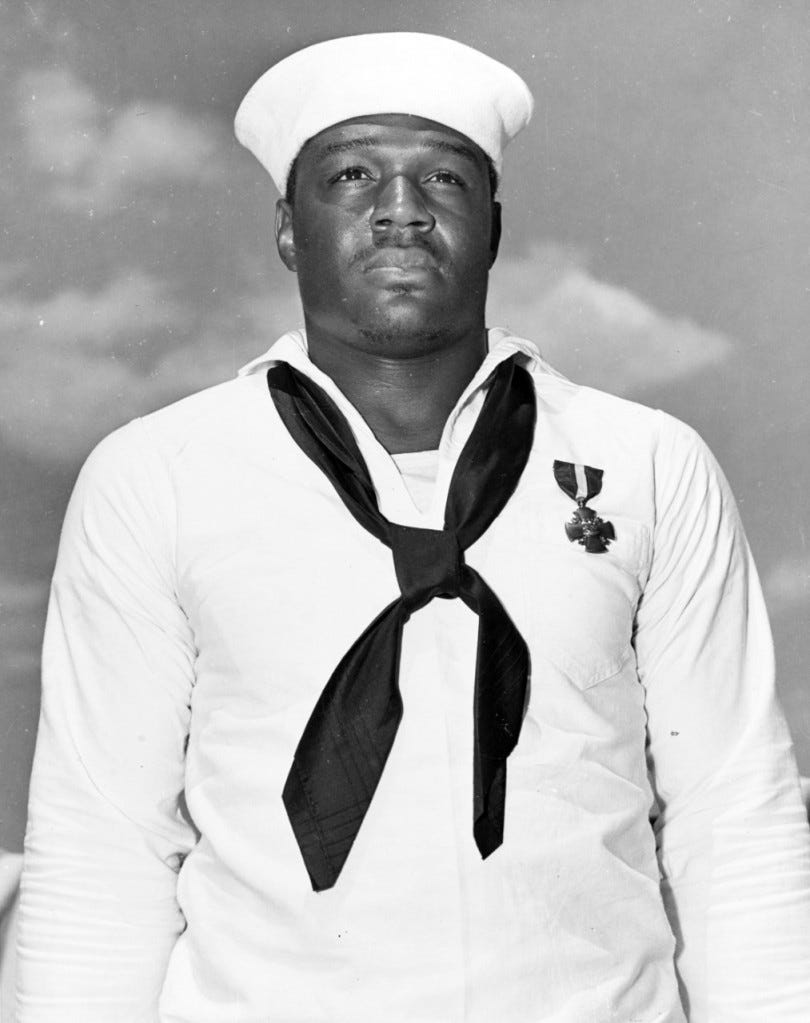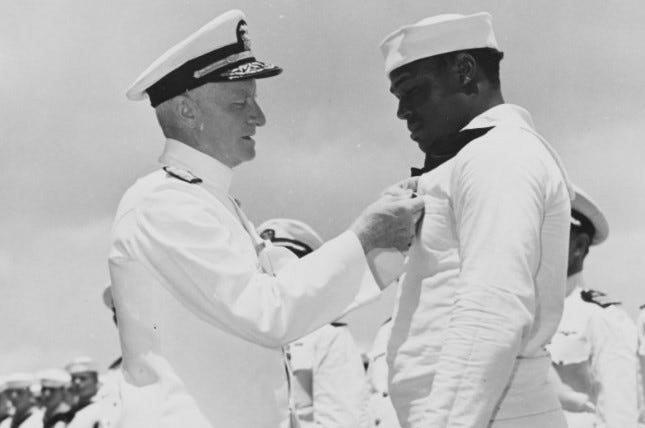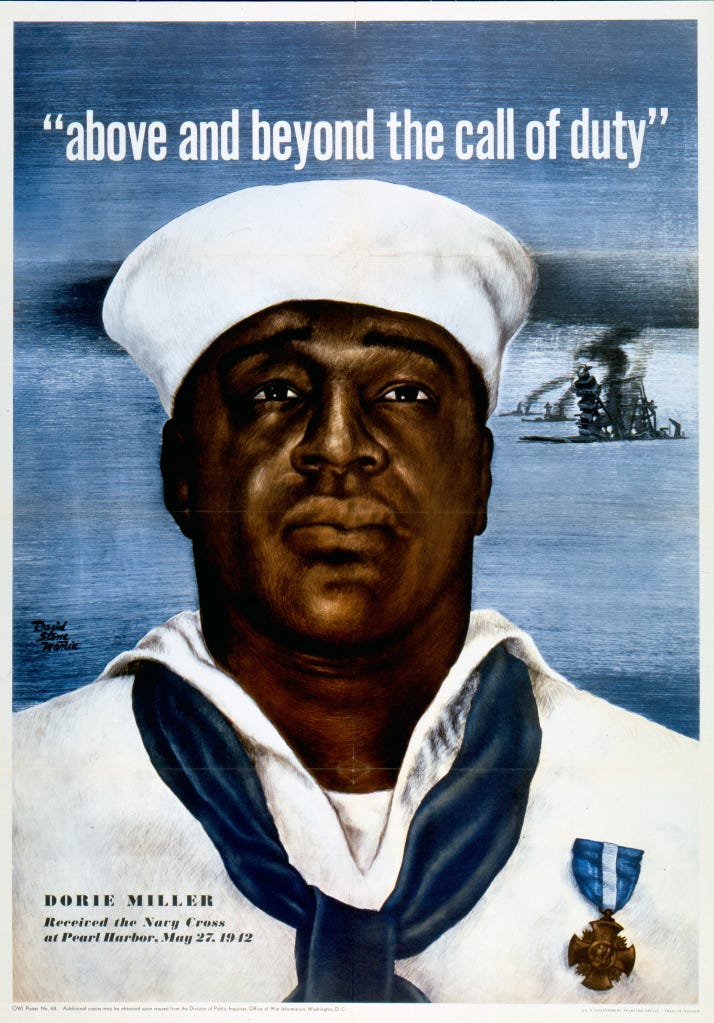Dorie Miller at Pearl Harbor: Telling a hero's story
On December 20, 1941, the U.S. Navy invited several members of the press corps to the officers' club at Pearl Harbor. Nearly two weeks after the Japanese attack that thrust the United States into war, men who saw action that fateful day told of the horrors and heroism they had witnessed on December 7.
No names were released to the public -- either of the men or of the ships on which they were stationed, though Elizabeth MacDonald of the Honolulu Star-Bulletin noted that these were not captains and admirals but more junior officers "who manned their battle stations under bomb blasts, fires and a hail of shell fragments. Many of these young officers took over as their commanding officers fell in battle and carried on until late afternoon."
Her story, like those by fellow correspondents William F. Tyree of United Press, Ralph B. Jordan of INS and Tom Yarbrough of the Associated Press, consisted largely of quotes from those anonymous officers describing the day in their own words. One officer's anecdote in particular caught the attention of some readers. Here's how MacDonald wrote it:
He told a story, too, of a Negro mess attendant, who was up on the bridge with the dying captain.
"I don't know why he was up there, but one of the officers gave him a machine gun and told him to blaze away. He had never touched a gun in his life, but once he got it going, he fired till all the ammunition was exhausted."
Of course, not many people beyond Hawaii saw MacDonald's story, so it was the wire-service reports that really propelled that tidbit far and wide when they were published in many papers' December 22 editions. Though the AP story that appeared under Yarbrough's byline did not mention the incident, both the United Press and INS stories did, and they were printed in numerous newspapers including the New York Times, which ran Tyree's UP account.
The Black press seized on the account immediately. Most Black newspapers were weeklies, so they had a few days to try and scrape together more information on the man the New York Amsterdam Star-News called "the first colored American hero of World War II."
In its December 27 edition, the paper recounted the sailor's actions and noted low in the story that it had tried to identify the man: "In a long distance telephone conversation with officials of the Navy Department in Washington yesterday, the Star-News was informed that no names of heroes of the Pearl Harbor disaster have been released as yet." The paper noted that the name of Rear Adm. Isaac Kidd, who had been killed aboard the USS Arizona, had been widely publicized, but the Navy responded that his name had been released because he had been killed in action.
Rebuffed in that initial effort, the Black press could continue to push to identify the man, with one newspaper in particular making it a mission.
In mid-March 1942, the Pittsburgh Courier finally got its man with assistance from historian Lawrence D. Reddick, curator of the New York Public Library's Schomburg Collection of Negro Literature, who had also been pushing to learn the sailor's name.
The identification of Mess Attendant Second Class Doris Miller, who went by "Dorie", was significant enough news that the Courier announced it on Wednesday night, March 11, even though its next print edition wouldn't come out for three more days.
The Associated Press distributed the story across North America in the coming days, but that didn't deter the Courier from making a big splash of its own in its March 14 editions, with a giant headline blaring above the masthead:
Following weeks and months of intensive effort, in which every possible rumor was run down, The Pittsburgh Courier this week takes pride in announcing to America the name of Dorie Miller and the magnificently courageous part he played. Starkly dramatic is the official communique which The Courier obtained last week from unimpeachable sources and which as been verified by the Navy Department. It follows:
"At the time of the attack on Pearl Harbor, Mess Attendant Miller, in company with two officers and several enlisted men, was on the signal bridge of a battleship (the USS West Virginia).
"When the battleship was attacked, the commanding officer (Capt. Mervyn S. Bennion) received what was to prove a fatal abdominal wound. While others attempted to improvise a stretcher on which to lower their commanding officer to a less exposed position, Miller and a lieutenant manned a pair of machine guns and fired upon the enemy aircraft. They maintained their fire until the machine guns were put out of action by by encroaching flames from numerous blazes set by enemy bombs.
"Unable to improvise a stretcher, the officers and enlisted men, including Miller, managed somehow to carry their Captain to the deck and the shelter of an anti-aircraft gun, located on the port side of the vessel. Dying, the Captain ordered all hands to abandon ship. Flames made usual means of leaving the ship impossible, but Miller and the others finally succeeded in getting to shore by climbing hand over hand down ropes dangling from an overhead crane."
Thus is revealed the first Negro hero of World War No. 2 ... the first Negro naval hero and the youth who for months has been referred to by white columnists and radio announcers as the "unnamed Negro messman here."
His name finally known, Dorie Miller instantly become a hero in the Black community and beyond. The Courier filled in some of his backstory in its initial account, noting that he had been born October 12, 1919 in Erath, Texas, and was the third of Conery and Henrietta Miller's four sons.
Correspondent J.O. Cansler reported from Waco, where Miller grew up, about the family's background:
The father, now 47, is alert and thrifty. He has been a part of the county's growth for more than 20 years. A man of the soil, he pointed with pride to his surrounding farmland. Orchards, gardens, livestock and poultry spoke eloquently for the industry of farmer and Mrs. Miller. His modest little home site, high upon a hill overlooking Lake Waco, occupies the center of the 28 acres of rented ground. Yes, Mr. Miler rents his land from Mrs. J.R. Walker, but his expert knowledge of the soil makes him a valuable asset as a sharecropper.
Mrs. Miller is intelligent and staunchly religious. She saw to it that the Miller sons were reared in the church.
Dorie Miller had enlisted in the Navy in Dallas on September 16, 1939, signing on for a six-year hitch. He entered the service as a Mess Attendant Third Class and reported to Norfolk for training three days later. Initially assigned to the ammunition ship USS Pyro, he eventually was transferred to the West Virginia, which would remain his home through December 7, 1941 aside from a pair of stints on the USS Nevada for secondary battery gunnery school.
By that time he had become the ship's heavyweight boxing champion and been promoted to Mess Attendant Second Class. As the Courier pointedly noted in its March 1942 story on Miller, "In the Navy, you know, a Negro cannot advance above the role of messman."
Even before his identity was known, Miller already had become a talisman for the initiative the Courier had dubbed the "Double V" campaign -- Black Americans contributing to victory over the country's foreign enemies while also fighting for victory at home in the form of civil rights. A January 12, 1942 editorial in the Atlanta Daily World raged against the double standard:
This unnamed Negro sailor gave an example of bravery and resourcefulness under fire that would do credit to any member of the Navy. Yet, if he is still alive, he will not be permitted the opportunity even now to train in the use of a gun on an American naval vessel. He must remain what he was, a mess attendant, "privileged" only to clean tables, empty slops and clean the boots of some who might have but half of his intelligence and courage.
The thing that sticks out like a sore thumb in the Times account of this Negro mess attendant's action is that he "never before had fired a gun." Why? Only because this Negro and every Negro in the country is barred by the Navy's Jim Crow regulations from any post other than mess attendant.
This picture of the Negro mess attendant -- segregated, discriminated against, denied his elementary right of an equal opportunity for training and position in the nation's fighting forces, yet turning with cool courage to fight in defense even of those who might have discriminated against him -- this picture must cause the blood to boil in the veins of decent, democratic men and women.
Once a name had been put to the story, Miller became a cause célèbre of sorts. The Monday after the Courier's revelation, Rep. John D. Dingell Sr. of Michigan introduced H.R. 6800, which called for Miller to be awarded the Medal of Honor. Sen. James M. Mead of New York introduced a corresponding measure in the Senate.
"I realize that at a time like this, ofttimes men worthy of the honor, regardless of their race, have been overlooked," Dingell told the Courier. "I am convinced that Dorie Miller deserves to be honored with a Congressional Medal of Honor, and I will do everything in my power to see that he gets it."
That decision ultimately was beyond Dingell's reach. Secretary of the Navy Frank Knox wrote a letter to the Senate Naval Affairs Committee opposing the recommendation and the Senate ultimately voted it down in May. Reports in the Black press at the time indicated a significant factor in Knox's opposition was any Medal of Honor recipient's traditional privilege of the floor of the House of Representatives.
Despite that failed effort, Miller did end up being honored beyond the letter of commendation Knox had sent him earlier in the spring. On May 11, President Franklin D. Roosevelt approved awarding the Navy Cross to Miller, making him the first African-American to receive the decoration. Adm. Chester Nimitz personally presented the award during a ceremony on the deck of the USS Enterprise in Pearl Harbor on May 27, and Miller was officially promoted to Mess Attendant First Class five days later -- the latter move bumping his monthly pay from $60 to $66.
Throughout the war, the U.S. made a point of rotating soldiers, sailors, airmen and marines who had achieved some sort of public acclaim back to the States to speak at war bond rallies. To the Black press, it only made sense that Miller, who had been stationed aboard the USS Indianapolis since six days after the Pearl Harbor attack, should be afforded the same treatment. The Navy finally acquiesced late in 1942.
The public heard directly from Miller for the first time as the calendar turned to the New Year. Miller spoke to the Courier's West Coast correspondent, E.F. Joseph, on December 31 in Oakland, and had nothing but praise for the Navy in an article that ran on January 2, 1943. Included in the story was Miller's own brief account of his heroics:
"Several men had lost their lives -- including some of the high officers -- when the order came for volunteers from below to come on the upper deck and help fight the Japanese," Miller told Joseph. "Without knowing how I did it, it must have been God's strength and mother's blessing, I ran up only to find that the officers who had issued the order had been injured, so another fellow and I started to fire the big guns. And I actually downed four Japanese bombers. I might have brought down more -- but I am positive of four."
Miller did embark on a speaking tour from there, including an appearance at the Great Lakes Naval Training Center outside Chicago.
The Navy had opened its first segregated facility for training Black seamen, Camp Robert Smalls, at the training center in the summer of 1942. Miller spoke during a graduation ceremony there in January 1943, urging them to take advantage of their opportunities.
Among the men who would train at Camp Robert Smalls were future Hall of Fame outfielder Larry Doby, jazz legend Clark Terry, and playwright Owen Dodson. Dodson, who spent 30 years as a professor of drama at Howard University, was inspired to write a one-act play called "The Ballad of Dorie Miller," which was first performed by and for the men at Great Lakes in February.
Miller eventually traveled to his home state, where a mixed-race crowd of about 1,500 showed up at Ebenezer Baptist Church in Austin to hear him speak in early February.
Before long, it was time for Miller to get back to work.
Miller joined the original crew of the new escort carrier USS Liscome Bay that summer. The ship was commissioned August 7 and trained into the early fall before arriving in Pearl Harbor in late October. Two weeks later, the ship headed out on its first combat mission.
As part of Task Force 52, the Liscome Bay would support Operation Galvanic, the invasion of the Gilbert Islands. At 5 a.m. on November 20, U.S. ships began pre-invasion bombardment of the small islands of Tarawa and Makin. Liscome Bay was off Makin, her aircraft flying more than 2,000 sorties over four days as the Americans gained control.
By the 23rd, the Army's 27th Infantry Division considered Makin secured. Sometime during the day, though, the Japanese submarine I-175 entered the area. Before dawn on November 24, Liscome Bay and several other ships were southwest of Makin, near Butaritari Island, when at 5:10 a.m. an officer on the starboard side of the ship suddenly shouted, "Here comes a torpedo!"
But the crew had no time to react. A single torpedo slammed into Liscome Bay and a massive explosion almost immediately sent a column of fire skyward. The Navy's official report would later conclude that the torpedo hit a magazine filled with airplane bombs, with the resulting detonation creating far more damage than "even if two or three had hit simultaneously." According to the report, "considerable debris" landed on the USS New Mexico, which was about 1,500 yards away.
The grim conclusion: "There were no survivors from any part of the ship aft of frame 118. This, considered with the routes of escape of those individuals who did survive, establishes clearly that almost the entire after half of the ship was generally demolished."
The Liscome Bay sank in 23 minutes. Initial reports said about 640 of the more than 900 men aboard were lost (casualty figures remain inexact).
Miller's parents received word that their son was missing on December 7, of all days. The news appeared in brief items in a handful of Texas newspapers that day, with no official confirmation from the Navy.
That finally came about two weeks later, prompting a sorrowful series of banner headlines from the Black press, which lamented the loss of a hero -- and decried the continuing lack of opportunity for African-Americans in the service. (The Navy's first group of Black officers, known as the Golden Thirteen, would not be commissioned until March 1944.)
Family and friends held a memorial service for Miller in Waco on April 30, 1944, and he was officially declared "presumed dead" by the Secretary of the Navy on November 25, a year and a day after the Liscome Bay went down in the Pacific.
Decades later, Miller remains a prominent figure in Navy lore. In 1973, the service named a Knox-class frigate after him. The USS Miller served until 1991.
Earlier this year, the Navy announced that it will name a Gerald R. Ford-class aircraft carrier after Miller. The USS Doris Miller, slated to be operational by 2030, will be the first carrier named for an African-American and the first named for an enlisted service member.








